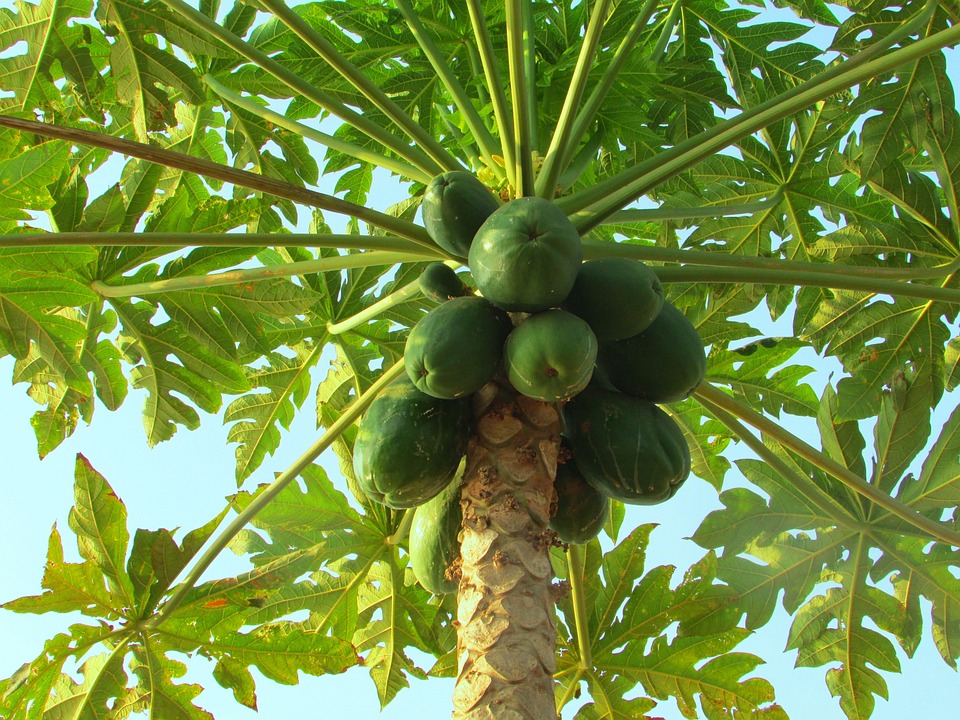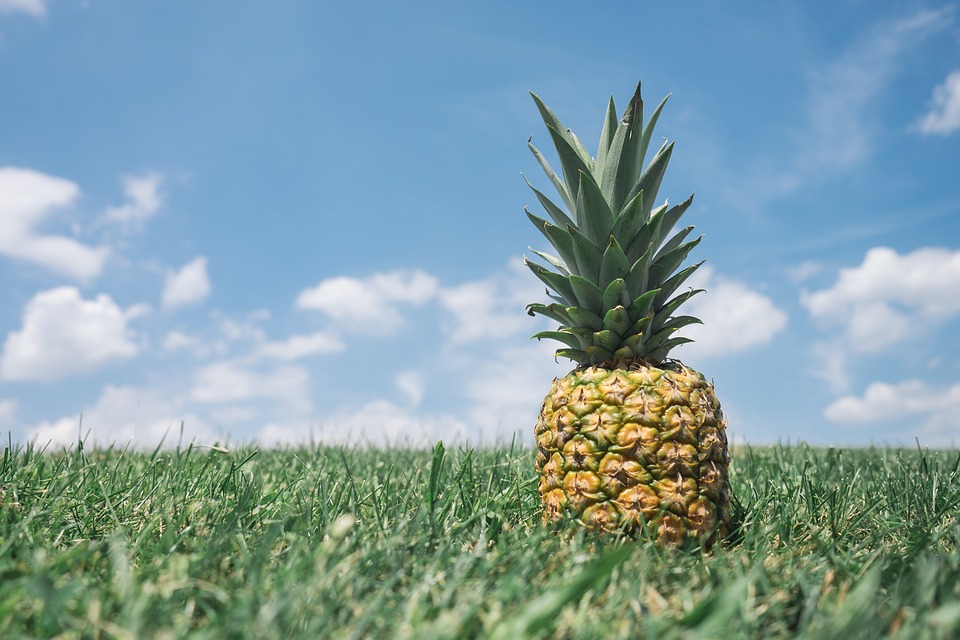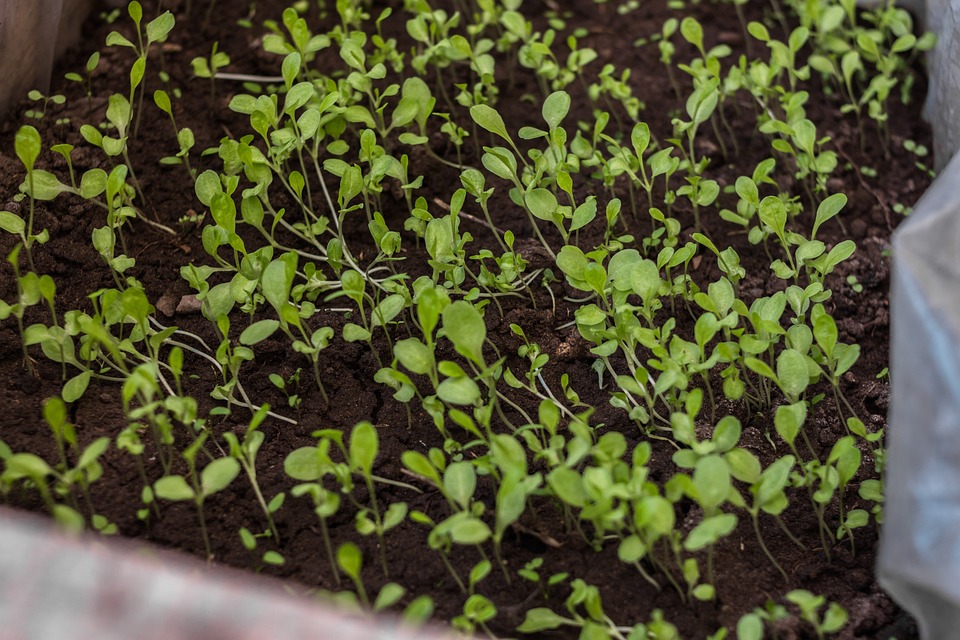Follow the Easy Tips to Grow a Papaya Tree in the ground or pots with this comprehensive guide and harvest juicy, delicious fruits.
Papaya trees can be a valuable addition to your garden or backyard, providing delicious and nutritious fruit. However, growing them can be a challenge, particularly for those without prior experience. In this regard, here are some useful Tips to Grow a Papaya Tree successfully.
Botanical Name: Carica papaya
Other Names: Banane de Prairie, Caricae Papayae Folium, Carica papaya, Carica peltata, Carica posoposa, Chirbhita, Erandachirbhita, Erand Karkati, Green Papaya, Mamaerie, Melonenbaumblaetter, Melon Tree, Papaw, Pawpaw, Papaya Fruit, Papayas, Papaye, Papaye Verte, Papayer, Papita.
USDA Zones: 9-12
Learn How to Grow a Mango Tree in a Pot
Papaya Tree Information
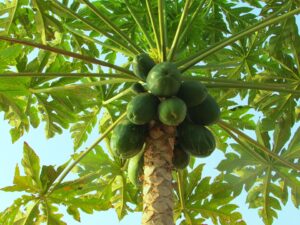
The Papaya tree (Carica papaya) is a tropical fruit native to Mexico and Central America. Today, it is cultivated in various tropical regions across the world.
This tree has a single, erect, segmented, and hollow stem with no branches. Its large, lobed leaves have an ornamental appearance. The plant can grow up to several meters tall (typically 6-33 feet) and have shallow roots, making them suitable for container planting.
The papaya fruit is classified as a berry. It has smooth skin and fleshy pulp. Inside the fruit, there is an open cavity that contains numerous small black seeds. The fruit comes in various shapes, including globose, ovoid, obovoid, and pyriform, and can range in size from 3 to 18 inches long and weigh between 1/2 to 22 pounds.
Learn to Grow Ashwagandha here
Papaya Tree Pollination
Papaya plants are categorized as male, female, or hermaphroditic (bisexual). The production of fruit is solely reliant on female or bisexual plants. Male plants bear small, tubular, yellow flowers with 10 anthers in each.
However, female plants have large yellow to whitish flowers with a visible ovary at the end of the flower cyme. Bisexual plants have perfect flowers that grow in small cymes in the leaf axils along the trunk.
In orchards and papaya plantations, it is typical to plant one male tree for every ten female trees to ensure successful pollination.
Although, hermaphrodite papaya trees are self-pollinating and, thus, do not require male trees for pollination. As a result, many commercial growers prefer planting them. If you plan to grow a papaya tree, it is necessary to plant either female or self-pollinating papaya trees to obtain fruit.
Find Is It Safe to Eat Cashew Fruit?
Best Climate to Grow a Papaya Tree
Papayas thrive in regions where the average temperature is between 70°F to 90°F throughout the year and are best grown in USDA growing zones 9 to 12. It is important to note that papayas are highly susceptible to frost, and exposure to temperatures below 29°F can cause significant damage or even kill the tree.
Additionally, root growth may be stunted in temperatures below 60°F, while flowers may fall off in temperatures above 90°F (32°C) or below 59°F (15°C).
Tip: To prevent potential damage to your papaya tree and fruit. It’s important to avoid planting in areas with a constant breeze and low spots that accumulate cold air. Such conditions can cause harm to the tree or even topple it over.
Choosing the Right Papaya Plant
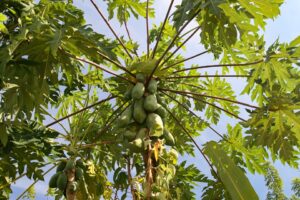
The Hawaiian papaya with yellow skin boasts a luscious and tropical sweetness. The fruit weighs approximately one pound, and the tree can grow up to 8 feet in height.
The Mexican papaya with red skin offers a milder yet still sweet flavor compared to the Hawaiian variety. The fruit weighs around 10 pounds, and the tree can grow between 10 to 12 feet tall.
Note: To ensure a healthy start for your papaya plant, select a nursery plant that stands between 6 inches to 2 feet tall and is grown in a container ranging from 1 to 3 gallons in size. Avoid purchasing tall plants that are confined in small pots, as they may be root-bound and not suitable for planting.
Best Papaya Varieties
Bluestem has thick flesh and a rich taste, suitable for Florida.
Graham has juicy and firm flesh with great flavor; the fruit is small to medium in size, suitable for Texas.
Waimanalo (Waimanalo Solo, X-77) offers round fruit with orange-yellow, flavorful flesh.
Sunset (Sunset Solo) is a dwarf tree that produces small to medium pear-shaped sweet fruit with orange-red skin and flesh.
Vista Solo is self-fertile; the fruit has yellow skin and orange-yellow sweet flesh.
Solo offers red-orange, very sweet flesh and produces bisexual blooms.
Sunrise (Sunrise Solo) has red-orange flesh with high sugar content. The papaya tree grows up to 3 feet in 9 months.
Mexican Red has rose-hued flesh, and the medium to very large fruit is not as sweet as Hawaiian types
Mexican Yellow bear medium to large, very sweet fruit with yellow flesh.
Kamiya is a dwarf tree that produces small to medium-sized, very sweet, juicy fruit.
Betty bears fruit early and offers very tender flesh with amazing taste.
Read about Kajari Melon Care in Pots and Garden
Growing Papaya from Seeds
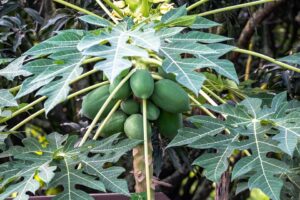
Obtaining the Seeds
- To grow a papaya tree, purchase seeds from a reputable source instead of extracting them from store-bought papaya fruits.
- This approach ensures that you know precisely what you are buying and can acquire a self-fertile, bisexual tree.
- The majority of hybrid papaya varieties are either bisexual or female, and it is advisable to purchase them.
- If seed germination is not of interest to you, purchasing young papaya plants from a local nursery or an online seller is the best option.
- However, if you decide to sow seeds obtained from the fruit.
- It is recommended to select seeds from elongated fruits instead of rounded ones. This is because elongated fruits have a higher likelihood of containing hermaphrodite (bisexual) seeds, with a probability of 66%, compared to 33% female seeds.
Tip: Cross-pollination from hand is necessary to pollinate female papaya trees.
Germinating the Papaya Seeds
- For Propagating papaya, either wash the seeds to remove the gelatinous coating or soak the seeds in a container filled with neutral water for four days.
- Change the water twice a day. After two days of soaking, separate the seeds that float on the surface from those that have settled down.
- Leave the settled seeds for another day and remove any seeds that float to the surface. This ensures that only viable seeds remain on the last day.
- Add fungicides to the water when changing it.
- After this process, place the seeds on a moist cotton cloth for two days, ensuring they remain moist. Once a white dot appears on the seeds, they are ready for sowing.
- You can sow the seeds directly on the ground or in a container.
- If using seed pots, ensure they are biodegradable since papaya plants do not transplant well, and transplanting them can result in a low success rate.
- Germination of seeds typically occurs within 1-3 weeks, although in suboptimal conditions, it may take up to 5 weeks, so patience is advised.
Note: The ideal temperature range for germination is approximately 70 degrees Fahrenheit (20 degrees Celsius).
Planting & Propagating Papaya
After the seedlings have germinated, they should be sown directly at the desired location. If you have purchased plants from a nursery, it is important to prepare the planting site thoroughly before planting. Dig a hole that is twice as wide as the root ball of the plant but at the same depth.
Apply a slow-release fertilizer such as 16-48-0, 18-46-0, or a balanced 15-15-15 fertilizer as per the direction on the product label. Use a weaker dose of the fertilizer at the base of the planting hole. Cover it with a thin layer of soil to prevent direct contact between the plant roots and the fertilizer.
Note: To prevent rot at the base of the stem, plant each seedling with its base 1 cm above the ground level. After transplanting, applying a fungicide can offer increased protection, especially if done during periods of rainfall.
Follow Tips to Grow Chia Seeds at Home
How to Grow Papaya in Pots?
It’s easy to grow a papaya tree in pots as they have shallow roots and are short-lived trees. Any papaya variety can be grown in a pot by pruning the top. Still, it’s better to choose a dwarf variety like Hawaiian papaya, which rarely grows over 8-10 feet compared to Mexican papaya.
To grow a papaya tree in pots, begin by choosing ripe and healthy seeds from papaya fruit, or you can buy them from a nursery. Next, plant the seeds in citrus or palm potting mix. Keep them warm and moist, and place them in a sunny spot until they germinate and develop into young plants.
Choosing a Container
Opt for a container that is at least 24 inches wide and deep, but if you can find a larger size, that would be ideal. Old drums, barrels, and buckets can also be suitable options for planting papaya.
How to Grow a Papaya Tree in a Cold Climate?
Suppose you intend to grow papaya in a region with a temperate climate. In that case, plant it in a big container and attempt to safeguard it from harsh weather conditions during winter, for instance, by placing it in a secure indoor space such as a greenhouse.
An alternative approach, start the papaya seedlings indoors during the fall or early spring. After the temperature rises sufficiently, the seedlings can be transplanted outside. Allow them to grow until the arrival of frosty weather, which may lead to their demise. However, there is a chance that some delectable papayas may be produced. Even if no fruits are yielded, these plants can be visually appealing.
Note: In the absence of a greenhouse, it is advisable to bring the papaya plant indoors during the winter months and place it in a warm room. To protect the roots and provide insulation, cover the pot with bubble wrap. During winter, reduce watering and stop fertilization.
Ideal Growing Conditions for Papaya Tree
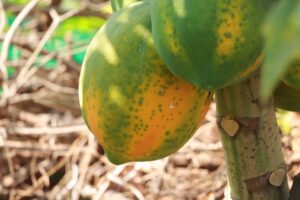
Location
For optimal growth and sweet fruit, it’s essential to grow a papaya tree in a location with full sun exposure, receiving at least 6-7 hours of sunlight each day. Partial shade can hinder fruit sweetness. Therefore, it’s best to choose a warm spot that receives plenty of sun and heat, preferably facing south and positioned against a wall that can reflect heat if available.
Soil
Grow a papaya tree in fertile, sandy, loam, well-draining soil rich in organic matter, with a pH ranging from 5.5 to 6.5 for optimal growth.
Avoid using soggy soil, as it can kill your papaya tree. Before planting, remove any rocks or debris that could impede root growth. The depth of soil is crucial for healthy root development, the soil above a meter deep will be ideal.
Note: To grow a papaya tree, drainage is essential. The ratio of sand, clay, and slit decides the form and soil texture.
Water
Water plays a vital role in papaya plants, as they consist of about 85% water. In the germination stage and the initial few months after planting, papayas require substantial amounts of water to support their growth.
During the dry season, it is essential to increase watering. However, it is important to ensure that the soil remains slightly moist and not overly wet. A general rule, deeply water the papaya plant when the top layer of soil, about one inch in depth, becomes dry.
Note: Do remember overwatering can result in the yellowing of young leaves, premature flower drop, and root rot. At the same time, insufficient moisture in the soil can lead to stunted growth, early aging and shedding of leaves, and premature fruit drop.
Temperature
The ideal temperature range for papaya cultivation falls between 68-90 F (20-32 C). Lower temperatures result in a reduced growth rate, while higher temperatures adversely affect production.
Papaya trees can endure brief exposure to temperatures as low as 32 F (0 C) but cannot withstand prolonged exposure to extreme heat above 100 F (38 C), heatwaves, and drought. In such conditions, the plant suspends its growth, and flower buds fall.
Read about Chilacayote Squash Care
Papaya Tree Care
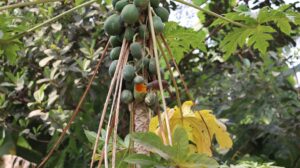
Mulching
To grow a papaya tree, use organic matter as a mulch to retain moisture around the plant, which is crucial in hot climates. Ensure that the mulch is kept 6 to 12 inches away from the trunk of the tree.
Additionally, it provides protection from both hot and cold weather conditions.
Fertilizer
To promote the healthy growth of your papaya tree, apply a generous amount of aged manure or compost regularly around the base. Opt for an organic fertilizer with slightly higher phosphorus than nitrogen and potassium levels, such as 5-10-5. During active growth periods, feed the plant every 2-4 weeks.
Once the tree begins to bear fruit, reduce the feeding frequency to once every 7-8 weeks and dilute the feed to half of the recommended strength.
Pests and Diseases
The papaya tree is susceptible to various pests, such as fruit flies, mites, black vine weevils, aphids, leafhoppers, and whiteflies. Additionally, it is prone to diseases including soil fungi, powdery mildew, fruit rot, papaya ringspot virus, and nematodes.
How to Harvest and Store Papayas
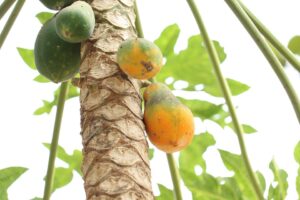
- Papaya trees typically bear fruit within a year of germination.
- The plant produces flowers approximately 4 months after planting, and fruits can be harvested between 7 to 11 months after planting.
- When ripe, papayas will display a yellow or amber-to-orange hue, depending on the variety.
- They will also be fragrant and slightly yield to gentle pressure.
- Unripe papayas can be picked and allowed to ripen off the tree, but the sugar content of the fruit may be lower.
- It is possible for unripe papayas to ripen at room temperature, but very dark green fruits may not fully ripen.
- For optimal storage, ripe papayas should be refrigerated in a plastic bag and consumed within 4 to 7 days.
Tip: Harvesting of the fruits should be done in the early hours of the day. It is important to avoid exposing them to direct sunlight.
Find the Best Companion Plants for Okra
How to Eat Papaya?

Ripe papaya is commonly consumed fresh and is a popular ingredient in fruit salads, desserts, and drinks. The mild flavor of papaya can be enhanced with a spritz of lime juice. When serving, papayas are often chilled, cut in half, and seeded, with the flesh scooped out using a spoon.
For fruit salads or compotes, skinned and sliced papaya can be added. Pureed ripe papaya is a great addition to sherbets, ice cream, and beverages.
Green, unripe papaya can be used to make pickles chutneys and also used for tenderizing meat. Non-ripe papaya can be added to green salads.

